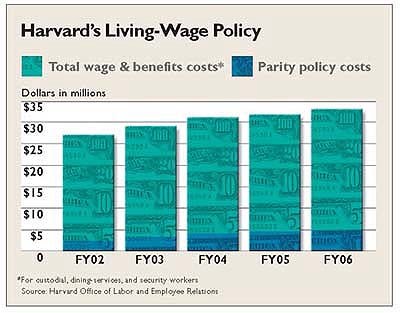The dataor at least some dataare now in on the effects of Harvard's new Wage and Benefits Parity Policy (WBPP) for custodial, dining-services, and security workers. The WBPP implements the recommendations of the Harvard Committee on Employment and Contracting Policies (HCECP), which former president Neil L. Rudenstine created as part of the agreement that ended a prolonged occupation of Massachusetts Hall by "living-wage" activists in the spring of 2001.
In January 2002, President Lawrence H. Summers approved the HCECP recommendations (see "Living Wage: Next Stage," March-April 2002, page 58) and they have gone into effect during the past year as the University negotiated contracts with the relevant labor unions. The new contracts raised the floor of union members' pay scales and made wages and benefits paid by Harvard's outside contractors comparable to what the University pays its in-house staff. Now the first figures are available regarding the price of such parity and, according to professor of economics Lawrence Katz, who chaired the HCECP, "In the short run, at least, things seem to be working out well."
For the three service sectors (custodial, dining, and security), the total annual wage and benefit costs are projected to grow from $26.5 million in the 2002 fiscal year to $33.5 million in fiscal 2006, representing a 4.9 percent annual increase. The fraction of wage and benefit costs attributable to the WBPP rises steadily from the 2002 fiscal year's $2 million to $4.9 million by fiscal 2006 (see graph on page 74). On average, 68 percent of these incremental costs are due to wage increases and 32 percent due to benefits. "The wage costs are slightly higher than we predicted," says Katz, "because the University ended up making somewhat more generous wage settlements than the minimum levels the committee recommended. Harvard went beyond minimum wage and benefit levels and created a parity policy that provides absolute parity at all parts of the wage structure."
 |
| Chart by Steve Anderson |
For example, at Harvard's on-campus restaurants and cafés, cooks typically earn more than cashiers. Although the HCECP recommended only the establishment of minimum pay rates (ranging from $10.83 to $11.30 per hour) for all dining-services personnel, Harvard's collective bargaining agreement with food-service workers ensures that cooks who work for an outside contractor will earn what a Harvard cook earns, not just what cashiers earn.
"The workers are very happy," says associate vice president for human resources Polly Price. Higher pay and benefits may, over time, help Harvard attract a better-educated, better-qualified staff. In the meantime, contractors who deploy personnel at multiple sites are finding that workers, unsurprisingly, prefer the enriched compensation environment of Harvard. The outcome is a more stable University workforce"from Harvard's point of view, that's a positive," Katz says.
Outside contractors, in contrast, are unenthusiastic about having to offer their employees a "living wage" scale at Harvard and lower, market-driven rates at other sites. The differential reduces the contractors' flexibility in moving employees among different work sites as required by, say, seasonal factors like the closing of the Law School cafeterias in summer. "People will say, 'What do you mean, you want to take me off the Harvard account?'" Price explains. Furthermore, "This is going to make it more difficult for large contractors to do the kind of employee development they usually do, by moving people around to different accountshaving people do something they haven't done before, to make them well-rounded," she says. "People will want to stay at Harvard, and not take advantage of those nonmonetary advancement opportunities"opportunities that can, in some cases, lead to management jobs.
Another unintended (if not unanticipated) consequence of the WBPP stems from a key aspect of the benefits-parity equation. If outside contractors do not offer health, dental, and pension plans comparable to Harvard's plans in these areas, they are obligated to increase their employees' hourly wages to compensate. For example, Harvard contributes 6 percent of wages to a pension fund; a contractor who contributes only 2 percent must add an additional 4 percent to the hourly wage paid to employees at Harvard. In general, large companies have health plans, but small companies do not, and don't intend to get them. As a result, "You'll see the 'nationalization' of vendors at Harvard," Price predicts. "The large, national companies that have health, dental, and pension plans will tend to supplant the 'ABC Cleaning Companies'smaller, locally owned, 'Mom and Pop,' minority- or women-owned businesses."
Given Harvard's decentralized structure, the WBPP costs are not, of course, evenly distributed. The Faculty of Arts and Sciences (FAS) accounts for about 19 percent of all external security, dining, and custodial services. FAS and the Medical School together incur about 50 percent of all external security-services costs. The Law School and the Kennedy School of Government are responsible for 99 percent of external dining-services costs.
All parts of the University, along with its vendors and employees, seem unanimous about the value of one particular fringe benefit, the Harvard Bridge to Learning and Literacy Program. The "Bridge" program gives training in basic literacy and computer skills, English competencies, and GED-diploma preparation for entry-level service workers during their Harvard workday. Launched in 2000, it enrolled 442 students in classes in the fall of 2002; there were 38 additional students working with Bridge tutors on their own time. Anecdotal evidence suggests the program's impact: a former Faculty Club waiter, for example, is now a financial-aid officer at the University of Miami. And Bridge graduate Yesenia Quezada, an elementary-school teacher in her native El Salvador who is now a custodian at the Museum of Natural History, teaches an eight-week beginning Spanish class to 15 central-administration employees. Many of these students are interested in learning how to converse with their Spanish-speaking co-workers.
Multilingual communication can even directly affect compensation. Last November, during the "open enrollment" period for fringe benefits, the human-resources office offered presentations in Spanish and Portuguese as well as English. "For service workers in [the custodial, dining, and security] categories, we saw a jump in benefits enrollment," Price says. "The fraction signing up for health insurance rose from 63 percent to 71 percent. A lot of people didn't even realize that they had these benefits." In ways like this, Harvard's initiatives may be achieving their aim of more fully integrating Harvard's service workers into the University community.





